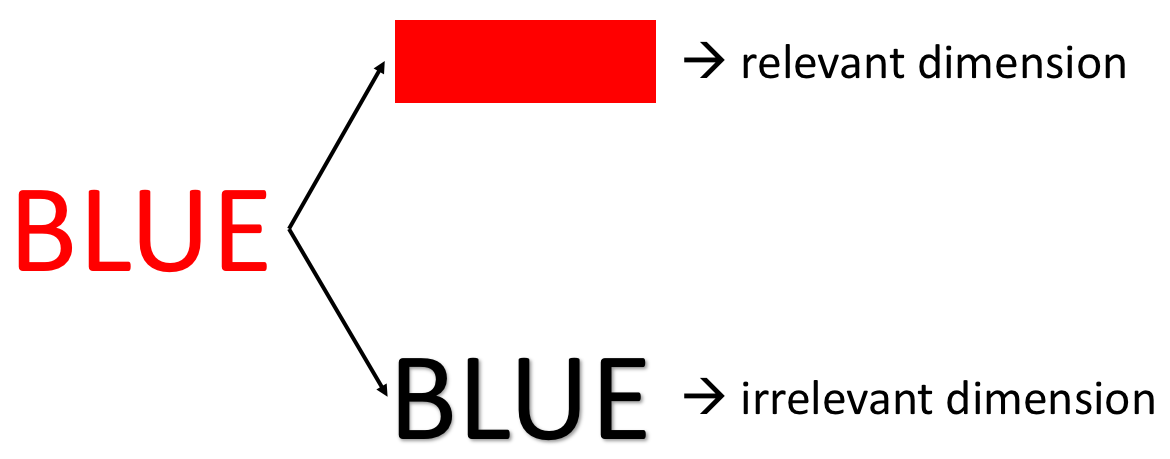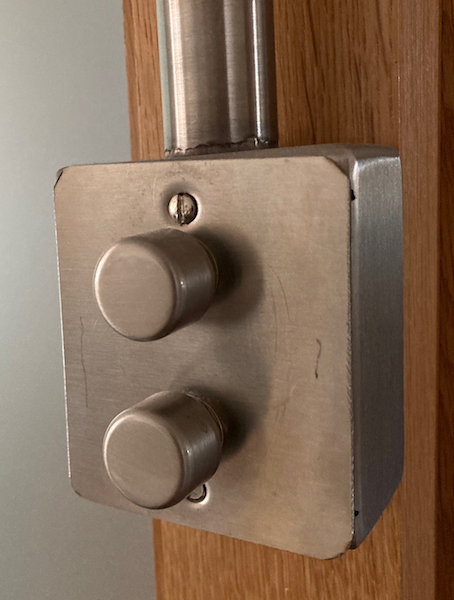Chapter 16 Interference tasks
In interference tasks, there are at least two sources of information or dimensions presented to the participant; one of these is relevant and the other irrelevant. The most popular example of an interference task is the Stroop task. In the Stroop task, participants are typically instructed to indicate the colour of the word and to ignore the meaning of the word. Thus, the colour of the word is the relevant dimension, and the meaning of the word the irrelevant dimension (see Fig. 16.1).

Figure 16.1: Relevant and irrelevant dimensions in the Stroop task.
In a trial11, the two sources of information can be conflicting, in agreement, or they are unrelated. When they conflict, the trial is incongruent or incompatible. When they are in agreement, the trial is congruent or compatible. And when they are unrelated, the trial is neutral. Fig. 16.2 illustrates these three trial types for the Stroop task.

Figure 16.2: Incongruent, congruent and neutral conditions in the Stroop task.
Here is a version of the Stroop task that you can try out. There will be 36 practice trials during which you will receive accuracy feedback, followed by another 36 experimental trials. Note that the neutral trials in this version involve words that are not usually associated with a particular colour. After completing the task, you will get feedback on your mean response times for congruent, neutral and incongruent trials. You will also have the option to download your own data.
Click here to run the Stroop task.
If you would like to rerun the task, please reload the page.
When a trial is incongruent, the presence of both dimensions creates cognitive conflict that has to be resolved to give a correct response. Resolving this conflict takes time and effort. Therefore, your incongruent mean RT should be slower than your congruent mean RT and your neutral mean RT. (Sometimes, but not as consistently, facilitation is observed. That is, your congruent mean RT might be faster than your neutral mean RT.)
The interference effect is a measure of the time and effort it takes to resolve the interference. It can be expressed as a slowing down in response time. For example, we might say that participants were on average 200 ms slower in incongruent Stroop trials as compared to congruent Stroop trials. The interference resolution can also fail and the participant might give an incorrect response. Thus, an interference effect can also result in increased error rates. For example, we might say that the average difference in error rates in incongruent and congruent Stroop trials was 15%.
Interference effects are relevant for basic cognitive psychology as they reveal how well we are able to focus on relevant information and ignore irrelevant information. They are also relevant in applied contexts, for example when designing user interfaces for appliances, machines or software. Here is an example from my own home: There are two sets of lights in the dining area, one on the ceiling and one on the wall. Here is the light switch:

When we moved in, the switch on the bottom was for the light on the ceiling, and the switch on top for the light on the wall! This is an example of spatial stimulus-response incompatibility, and I can assure that this layout proved to be very confusing!
Think of a trial as a stimulus-response cycle in an experiment. In the Stroop task, a trial begins when a colour word is presented. After a short time, the participant responds (e.g., by pressing a key on a keyboard). After the response, there might be a short break of a few 100 ms. This completes the trial. Overall, a trial in the Stroop task might take about 1 to 1.5 s. Clearly, this is very different from the meaning of the word “trial” in the context of a clinical trial where “trial” refers to the complete study. Make sure to distinguish these two meanings! Also, be aware that “trial” might be auto-corrected to “trail” by some pieces of software. If this does happen, you might want to tell your software that it should not auto-correct “trial”.↩︎